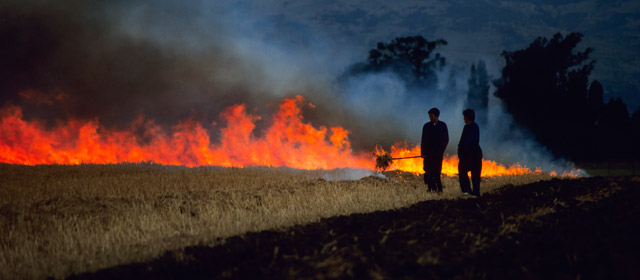Story summary
In the past, people set fire to trees and plants to clear the land for animals and crops.
Māori use of fire
When Māori first settled in New Zealand, around 1250–1300 AD, most of the land was covered in forest. They burned large areas, to make hunting birds such as moa easier.
One of their main foods was fern root. Regular burning of the fernlands stopped other plants from growing there. After the fire, new ferns would spring up.
Māori also grew kūmara (sweet potato). They burned the ground to prepare it for planting. Ash from burnt scrub and fern was put into the soil to nourish the crop.
South Island: burning tussock and shrubs
European settlers cleared large areas in the South Island for sheep farms. Burning the tangle of tussock, shrubs and small trees made it easier to travel, and created pasture for sheep to graze. It also killed weeds and stopped them invading farmland.
North Island: burning forest and fernlands
North Island farmers used fire to turn the forest and fernlands into grazing land for sheep and cattle.
- In winter they cut down the forest’s lower creepers and shrubs. Then they cut down the trees. After drying out over summer, the plants were set alight. Later, farmers sowed grass seed on the ash.
- In autumn, farmers burned the fern and sowed grass and clover seed. Sheep or cattle ate the grass, and any ferns that grew back.
Erosion and other damage
Grass did not bind the soil, so after the trees were burnt it no longer held together so well. Also, removing trees on hillsides increased the amount of soil that washed down after rain. This led to erosion, flooding and landslides.
In hot, dry weather, fires could spread quickly and destroy houses, farms and forests.
Burning today
Since the 20th century, farmers have seen burning as less necessary, and there are strict rules. Ways to manage the land include:
- controlling weeds with fences or herbicide
- using fertiliser for better pasture
- intensive grazing by livestock, so that the weeds are eaten.





